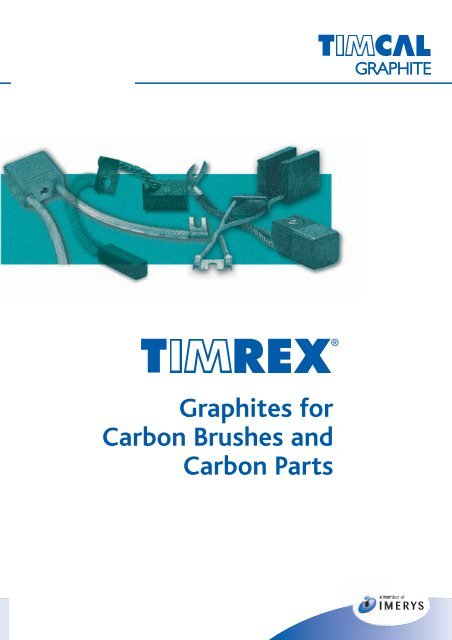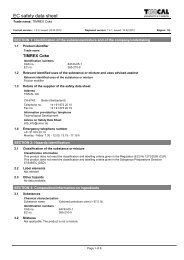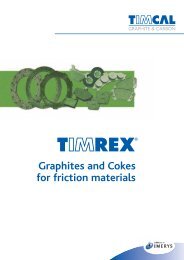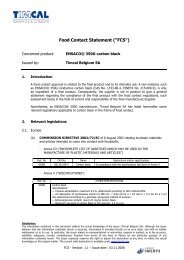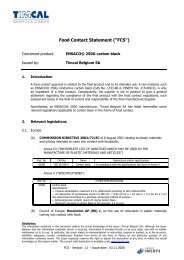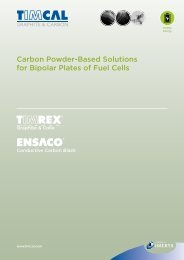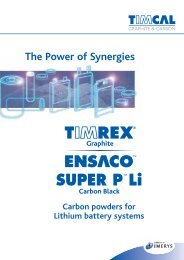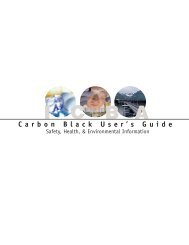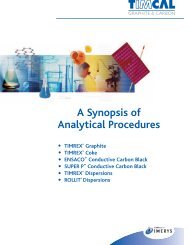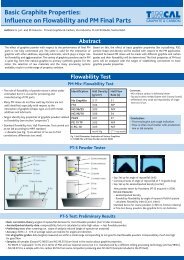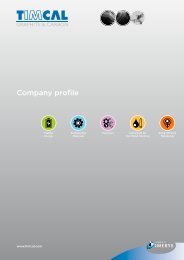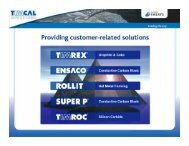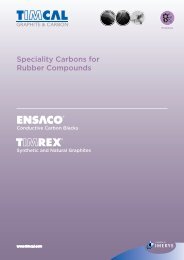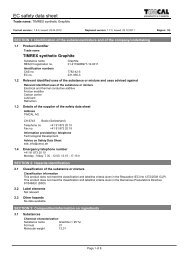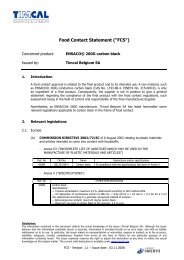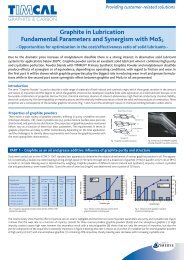DEF PROSPETTO spazzole - Timcal Graphite
DEF PROSPETTO spazzole - Timcal Graphite
DEF PROSPETTO spazzole - Timcal Graphite
You also want an ePaper? Increase the reach of your titles
YUMPU automatically turns print PDFs into web optimized ePapers that Google loves.
<strong>Graphite</strong>s for<br />
Carbon Brushes and<br />
Carbon Parts
Who are we?<br />
TIMCAL Group has a strong tradition<br />
and history in graphite manufacturing. Its<br />
first manufacturing operation was founded<br />
in 1908. Today, TIMCAL Group facilities<br />
produce and market a large variety of synthetic<br />
and natural graphite powders and<br />
dispersions of consistent high quality.<br />
Adhering to a philosophy of Total Quality<br />
Management and continuous process<br />
improvement, all TIMCAL manufacturing<br />
plants comply with ISO 9001-2000.<br />
TIMCAL is committed to produce highly<br />
specialized graphite materials for today’s<br />
and tomorrow’s carbon brush and carbon<br />
parts industries.<br />
TIMCAL has an international presence<br />
with facilities and commercial offices<br />
located in the key markets around the<br />
Globe. The Group’s industrial and commercial<br />
activities are implemented by an experienced<br />
multi-national team of nearly 300<br />
employees from seven countries on three<br />
continents.<br />
TIMCAL Group is a member of<br />
IMERYS, a world leader in adding value to<br />
minerals.<br />
www.timcal.com<br />
TIMREX ® <strong>Graphite</strong>s combine technical<br />
and economic advantages: their optimal<br />
price/performance ratio helps maintain a<br />
high quality level in the finished carbon<br />
part while, at the same time, reducing<br />
manufacturing costs.<br />
Bodio, Switzerland<br />
Lac des Îles, Canada<br />
Changzhou, China<br />
Fuji, Japan<br />
About carbon<br />
brushes<br />
This document is devoted to the complex<br />
field of manufacturing carbon shapes such<br />
as brushes, seals and engineering components.<br />
The variety of products are as different<br />
as the many procedures involved in their<br />
production.<br />
The “carbon parts world” is a unique<br />
industry having to comply with many and<br />
sometimes contradictory requirements such as:<br />
• Electrical and thermal conductivity.<br />
• Lubricity and hardness.<br />
• Mechanical strength and wear protection.<br />
• Corrosion resistance in - very often-<br />
aggressive environments.<br />
These circumstances and the exacting<br />
technical demands of this industry call for<br />
very well defined high performance raw<br />
materials of outstanding consistency.<br />
To help our customers make the best<br />
selection of raw materials for their needs,<br />
TIMCAL Group has produced this document<br />
to describe the full range of TIMREX ®<br />
<strong>Graphite</strong> grades available for this application
<strong>Graphite</strong> in<br />
carbon brushes<br />
and carbon parts<br />
Powders for carbon brushes<br />
and carbon parts<br />
Carbon brushes<br />
Sliding contacts<br />
Current collectors<br />
Resin-bonded<br />
Pitch-bonded<br />
Semi-metallic<br />
Sinter-metallic<br />
Carbon parts<br />
Mechanical seals<br />
Bearings<br />
Erosion electrodes<br />
Electrical resistors<br />
TIMREX ® <strong>Graphite</strong>s offer<br />
many advantages<br />
Predictable synthetic and natural<br />
graphites with narrow specifications and<br />
unequalled consistent quality due to:<br />
monitoring of all production and processing<br />
stages, strict final inspection, and<br />
clearly defined development processes.<br />
Unique properties thanks to the combination<br />
of a consistent purity, perfect crystalline<br />
structure and well defined texture.<br />
Market oriented product development.<br />
Application support by TIMCAL engineers.<br />
BASIC CHEMICAL, PHYSICAL AND APPLICATION-<br />
RELATED PROPERTIES<br />
The carbon brushes manufacturers require a carbon with consistent electrical<br />
resistance (for high as well as low conductivity purposes), high lubricity, consistent<br />
compressibility and predictable absorption level of binder.<br />
Electrical conductivity<br />
The electrical conductivity is strongly<br />
influenced by the crystallinity and particle<br />
size. A high anisometry of the particle shape<br />
leads to an anisotropic behaviour of the<br />
electrical conductivity.<br />
Absorption behaviour<br />
of binder<br />
The absorption behaviour is determined by<br />
particle size distribution, surface porosity,<br />
particle shape and surface tension between<br />
graphite and binder. The knowledge of these<br />
properties helps to make the correct selection<br />
of graphite and therefore reduces development<br />
time. Good processability and constant<br />
quality of the final product presuppose<br />
a high consistency of the absorption properties<br />
of the powders used.<br />
Compressibility<br />
Compressibility is dependent on particle<br />
size as well as on crystallinity. Other parameters,<br />
however, which are related to the texture<br />
of the particle also influence compressibility<br />
and can be correlated with mechanical<br />
properties.<br />
Lubricity<br />
Coefficient of friction<br />
Wear reduction<br />
High crystallinity and high chemical purity<br />
of the graphite powder lead to good lubrication<br />
properties. Low friction coefficient<br />
and low wear of the commutator are the<br />
consequence of these powder characteristics.<br />
The hardness of the graphite influences<br />
the wear of the carbon brushes. Lifetime of<br />
the brushes and the commutator is very<br />
often extended by mixing the high purity<br />
TIMREX ® <strong>Graphite</strong> with small quantities<br />
of well-defined polishing additives.
TIMREX ®<br />
<strong>Graphite</strong>s for<br />
carbon parts<br />
T <strong>Graphite</strong> T 44<br />
T 75<br />
T 15-75<br />
T 150<br />
KS <strong>Graphite</strong><br />
SFG <strong>Graphite</strong><br />
GB Natural<br />
<strong>Graphite</strong><br />
0 50 100 150<br />
Particle size range d (µm)<br />
0 50 100 150<br />
Particle size range d (µm)<br />
0 50 100 150<br />
Particle size range d (µm)<br />
0 50 100 150<br />
Particle size range d (µm)<br />
www.timcal.com<br />
Typical values<br />
SFG 6<br />
SFG 15<br />
SFG 44<br />
SFG 75<br />
SFG 150<br />
GB 99/6<br />
GB 98/75<br />
New<br />
KS 15<br />
KS 5-25<br />
KS 44<br />
KS 5-44 New<br />
KS 75<br />
KS 5-75 TT<br />
KS 150<br />
New<br />
Ash<br />
(%)<br />
0.07<br />
0.07<br />
0.03<br />
0.09<br />
0.05<br />
0.03<br />
0.06<br />
0.02<br />
0.07<br />
0.09<br />
0.06<br />
0.07<br />
0.07<br />
0.07<br />
0.07<br />
0.03<br />
0.6<br />
1.3<br />
Moisture<br />
(%)<br />
0.1<br />
0.1<br />
0.02<br />
0.05<br />
0.1<br />
0.1<br />
0.1<br />
0.03<br />
0.1<br />
0.02<br />
0.05<br />
0.1<br />
0.1<br />
0.1<br />
0.1<br />
0.01<br />
0.1<br />
0.1<br />
Crystallite height<br />
Lc (nm)<br />
> 100<br />
> 100<br />
> 100<br />
> 100<br />
> 80<br />
> 100<br />
> 100<br />
> 100<br />
> 100<br />
> 100<br />
> 100<br />
> 100<br />
> 150<br />
> 200<br />
> 200<br />
> 200<br />
> 400<br />
> 400
Particle shape<br />
angular flakes, microporous<br />
irregular spheroids<br />
strong anisometric flakes,<br />
needles<br />
flakes<br />
Tribological<br />
and mechanical properties<br />
- high toughness<br />
- good lubrication properties<br />
- medium toughness<br />
- good lubrication properties<br />
- low toughness<br />
- very good lubrication<br />
properties<br />
- very good lubrication<br />
properties<br />
Advantages and applications<br />
- low friction coefficient<br />
- low wear of the counterpart and low self-wear<br />
- good transfer-film formation<br />
- medium electrical conductivity<br />
- medium density of brushes and parts<br />
- suitable for pitch-bonded and resin-bonded brushes<br />
- low friction coefficient<br />
- low wear of the counterpart<br />
- good transfer-film formation<br />
- high electrical conductivity<br />
- suitable for pitch-bonded and resin-bonded brushes<br />
- very low friction coefficient<br />
- low wear of the counterpart<br />
- extreme good formation of transfer-film<br />
- very high electrical conductivity<br />
- excellent wettability with organic binders<br />
- excellent compressibility<br />
- high transverse rupture strength<br />
- suitable for pitch-bonded, resin-bonded and metallic brushes<br />
- very low friction coefficient<br />
- low wear of the counterpart<br />
- very high electrical conductivity<br />
- suitable for semimetallic and metallic brushes
Powder<br />
Properties<br />
<strong>Graphite</strong> powders and their<br />
influence on carbon parts<br />
TIMCAL Group is in the position to provide<br />
analytical and test results for graphite<br />
powders and the corresponding graphite<br />
compacts. Based on this information, conclusions<br />
can be drawn from the properties of<br />
the final products and vice versa.<br />
www.timcal.com<br />
Powder properties<br />
Purity<br />
Ash content<br />
Moisture<br />
Trace elements<br />
Crystalline structure<br />
Crystallinity<br />
Texture<br />
BET surface area<br />
Xylene density<br />
Scott density<br />
Oil absorption<br />
Particle size<br />
Particle size distribution<br />
Laser diffraction, sieving methods<br />
Thermal stability<br />
Properties of final products<br />
Wear<br />
Compact/brush<br />
Commutator/counterpart<br />
Friction coefficient<br />
Transfer film<br />
Brush temperature<br />
Density<br />
Commutation<br />
Electrical properties<br />
Properties of binder-free<br />
graphite compacts<br />
Compact density<br />
Springback<br />
Mechanical strength<br />
Electrical resistivity<br />
Oil absorption<br />
In the following pages there are some of<br />
the results of experimental work carried out on<br />
TIMREX ® <strong>Graphite</strong> at our Technical Centre.
Powder<br />
Properties:<br />
Compact density<br />
Compact density is a parameter describing the<br />
structure density available at given pressing conditions.<br />
The density of compact obtained is influenced by<br />
spring back and expansion of the compact after shaping<br />
and demoulding from the press.<br />
The difference between xylene density and compact<br />
density indicates the degree of interparticular porosity<br />
in the compact and compressibility of the powder. The<br />
minimum binder quantity required to achieve porefree<br />
dense composite materials can be calculated.<br />
As the figures show, compact density is influenced<br />
by pressure, particle size, crystallinity and other physical<br />
properties of the graphite particles. At high pressure<br />
values (p>5t/cm 2) the compact density becomes nearly<br />
pressure independent.<br />
For a small particle size, the compact density is<br />
hardly influenced by the particle structure. A high<br />
crystallinity results in a high compact density.<br />
W<br />
Pressure<br />
Die: L = 30 mm W = 20 mm<br />
Mass = constant<br />
L<br />
Density of compacts<br />
Density (g / cm 3 ) Density (g / cm 3 )<br />
2.2<br />
2.0<br />
1.8<br />
1.6<br />
1.4<br />
1.2<br />
GB<br />
SFG<br />
KS<br />
1.0<br />
0 20 40 60 80<br />
Particle size d90 (µm)<br />
2.2<br />
2.0<br />
1.8<br />
1.6<br />
1.4<br />
1.2<br />
Density of graphite compacts<br />
Die: 30 x 20 mm<br />
Pressure: 2.5 t/cm 2<br />
100 120 140 160<br />
1.0<br />
0<br />
Pressure (t / cm<br />
2 4 6 8<br />
2 )<br />
SFG 44<br />
KS 44<br />
T 44<br />
T<br />
10
Powder<br />
Properties:<br />
Springback<br />
Measuring method<br />
The springback is a reading giving the resilience of<br />
compacted graphite powder. A defined amount of dry<br />
powder is poured into a die. After inserting the punch<br />
and sealing the die, air is evacuated from the powder.<br />
Pressure is applied (p=0.477 t/cm 2 ) and the powder sample<br />
thickness is measured. Thickness is measured again<br />
after pressure has been released.<br />
Conclusion<br />
Springback and compact density of graphite powders<br />
are physically connected parameters, which give<br />
information about the compactibility of powders and<br />
dimensional stability of compacts in any pressing<br />
direction. Springback is influenced by pressure, particle<br />
size, crystalline structure ad other properties.<br />
Crystalline structure is the main parameter.<br />
A high crystalline structure results in low springback.<br />
Compacts produced from powders having a low<br />
springback can be easily formed and pressed with<br />
greater accuracy.<br />
Punch<br />
Seal<br />
Die<br />
Compact<br />
Vacuum line<br />
Pressure<br />
Pressure meter<br />
H(p)<br />
H(0)<br />
Spring back<br />
Metering<br />
element<br />
www.timcal.com<br />
Springback (%) Springback (%)<br />
25<br />
20<br />
15<br />
10<br />
5<br />
GB<br />
KS<br />
0<br />
0 20 40 60 80<br />
Particle size d90 (µm)<br />
25<br />
20<br />
15<br />
10<br />
5<br />
Springback of graphite compacts<br />
Die diameter: 20 mm<br />
Pressure: 0.477 t/cm 2<br />
100 120 140 160<br />
0<br />
0<br />
Pressure (t/cm<br />
0.2 0.4 0.6 0.8<br />
2 )<br />
H (0) - H (p)<br />
SB = x 100 %<br />
H (0)<br />
SFG<br />
T<br />
T 44<br />
KS 44<br />
SFG 44<br />
1
Powder<br />
Properties:<br />
Transverse rupture strength<br />
Measuring method<br />
The transverse rupture strength is measured on<br />
graphite compacts pressed to bars with size of 50x12x6<br />
mm and 30x20x10 mm without binder. Other measurements<br />
carried out on test pieces with dimensions of<br />
50x12x8 mm show comparable results.<br />
Conclusion<br />
The transverse rupture strength corresponds to the<br />
compressibility of powders, characterised by compact<br />
density, springback and expansion. Compact density<br />
and internal cracks influence the measured mechanical<br />
strength.<br />
The mechanical strength can be enhanced by<br />
increasing the compaction pressure and by using<br />
graphites of smaller particle size.<br />
With the increase of the degree of crystallinity the<br />
mechanical strength also increases.<br />
Compact<br />
Load<br />
L<br />
L = Distance between the supporting rods (20 mm)<br />
Transverse rupture strength (Arbitrary units) Transverse rupture strength (Arbitrary units)<br />
10<br />
8<br />
6<br />
4<br />
2<br />
GB<br />
SFG<br />
KS<br />
0<br />
0 20 40 60 80<br />
Particle size d90 (µm)<br />
7<br />
6<br />
5<br />
4<br />
3<br />
2<br />
1<br />
Transverse rupture strength of compacts<br />
Bar: 30 x 20 x 10 mm<br />
Pressure: 2.5 t/cm 2<br />
100 120 140 160<br />
0<br />
0<br />
Pressure (t / cm<br />
2 4 6 8<br />
2 )<br />
SFG 44<br />
KS 44<br />
T 44<br />
T<br />
10
Powder<br />
Properties:<br />
Electrical resistivity<br />
Measuring method<br />
The electrical resistivity is measured on defined<br />
compacted test bars (50x12x6 mm, compacting pressure:<br />
2.5 t/cm 2).<br />
In order to be able to distinguish between the various<br />
graphites a very accurate and reliable method has<br />
to be used. The four-point method applied for these<br />
measurements greatly reduces the possibility of errors<br />
due to poor contacts.<br />
Conclusion<br />
Information about the electrical resistance of compacted<br />
graphite powders is helpful for raw material<br />
selection from different graphite types. The T and KS<br />
types and mixtures of T and KS are mostly used for<br />
medium and highly ohmic brushes.<br />
SFG and GB types provide best performance in<br />
semi-metallic and sintermetallic brushes, where a high<br />
electrical conductivity is required.<br />
B<br />
A<br />
D<br />
A = Measuring electrodes<br />
B = Current carrying electrodes<br />
C = Silver contact adhesives<br />
D = Ohmmeter<br />
C<br />
www.timcal.com<br />
3<br />
2.5<br />
2<br />
1.5<br />
1<br />
0.5<br />
Electrical resistivity of graphite compacts<br />
Bar: 50 x 12 x 6 mm<br />
GB<br />
SFG<br />
0<br />
0 20 40 60 80<br />
Particle size d90 (µm)<br />
T<br />
KS<br />
The results of resistivity measurement of KS 75 and<br />
T 75 are somewhat misleading. It has to be taken into<br />
consideration that the compactability of the graphite<br />
affects the electrical resistivity because of microcracks<br />
and porosity. As already shown, these two graphites are<br />
relatively difficult to compact due to the coarse particle<br />
size.<br />
Other investigations have shown that in compounds<br />
containing a high amount of graphite the resistivity<br />
decreases with increasing particle size.<br />
Pressure: 2.5 t/cm 2<br />
100 120 140 160
Powder<br />
Properties:<br />
Oil absorption (DBP)<br />
Measuring method<br />
The oil absorption test is a special centrifugation<br />
method showing high reproducibility, developed by<br />
TIMCAL.<br />
A special centrifuge tube is filled with 0.5g of<br />
TIMREX ® graphite powder and then covered with<br />
dibuthylphthalate (DBP). After centrifuging for 90<br />
minutes at a relative acceleration of 453g, the tube is<br />
weighed and the oil absorption of 100g of powder is<br />
calculated (based upon the weight increase of the 0.5 g<br />
sample).<br />
Conclusion<br />
The oil absorption is a very useful tool to estimate<br />
the binder requirement. Various fundamental properties<br />
such as:<br />
• Particle size<br />
• Bulk density<br />
• BET<br />
• Crystalline structure<br />
as well as the wetting angle affect the absorption properties.<br />
Tube<br />
DBP<br />
Sample<br />
Filter<br />
Sieve<br />
Centrifugation<br />
Acceleration<br />
Oil absorption (g DBP / 100 g graphite)<br />
200<br />
150<br />
100<br />
50<br />
Oil absorption of graphite powders<br />
Oil: dibuthylphthalate DBP<br />
KS 5-44<br />
T 15-75<br />
KS<br />
SFG<br />
0<br />
0 20 40 60 80<br />
Particle size d90 (µm)<br />
KS 5-75 TT SFG 150<br />
100 120 140 160<br />
TIMREX ® <strong>Graphite</strong> has found its place in the field of carbon parts<br />
as a reliable, high quality product. Many problems can be solved<br />
thanks to the broad range of TIMREX ® <strong>Graphite</strong>s.<br />
Our specialists will be glad to help you in the selection of the<br />
most suitable product for your application.<br />
T
Commercial Offices<br />
Manufacturing Plants<br />
Distributors / Agents<br />
(full list available on request)<br />
Offered by your local Distributor/Agent:<br />
© 2001 TIMCAL Ltd., CH-Bodio<br />
No part of this publication may be reproduced in<br />
any form without the prior written authorisation<br />
of TIMCAL Ltd.<br />
Printed in Switzerland.<br />
Leading the way.<br />
TIMCAL Ltd.<br />
Head Office of the Group<br />
CH-6743 Bodio, Switzerland<br />
Phone: +41 91 873 20 10<br />
Fax: +41 91 873 20 19<br />
info@ch.timcal.com<br />
TIMCAL America Ltd.<br />
Representative Office<br />
29299 Clemens Road 1-L<br />
Westlake, Ohio 44145, USA<br />
Phone: +1 440 871 7504<br />
Fax: +1 440 871 6026<br />
info@us.timcal.com<br />
TIMCAL Japan K.K.<br />
Representative Office<br />
7F Sagamiya Bldg.<br />
6 Ichibancho Chiyoda-ku<br />
Tokyo 102-0082 Japan<br />
Phone: +81 3 3511 2078<br />
Fax: +81 3 3511 2077<br />
info@jp.timcal.com<br />
TIMCAL in France<br />
Representative Office<br />
Tour Maine Montparnasse<br />
33, avenue du Maine<br />
FR-75755 Paris Cedex 15, France<br />
Phone: +33 1 4538 3850<br />
Fax: +33 1 4538 3851<br />
info@fr.timcal.com<br />
TIMCAL Deutschland GmbH<br />
Representative Office<br />
D-56564 Neuwied, Germany<br />
Phone: +49 2631 890 737<br />
Fax: +49 2631 890 752<br />
info@de.timcal.com<br />
Changzhou TIMCAL <strong>Graphite</strong> Corp. Ltd.<br />
188# Taishan Road,<br />
Hi-Tech Zone, Changzhou<br />
213022 P.R. China<br />
Phone: +86 519 5100801<br />
Fax: +86 519 5101322<br />
info@cn.timcal.com<br />
STRATMIN <strong>Graphite</strong> Inc.<br />
2500 Boul. Daniel-Johnson<br />
Suite 906<br />
Laval, Quebec<br />
Canada H7T 2P6<br />
Phone: +1 450 686 8630<br />
Fax: +1 450 686 8725<br />
info@stratmin.com<br />
CB-01 10.2001


